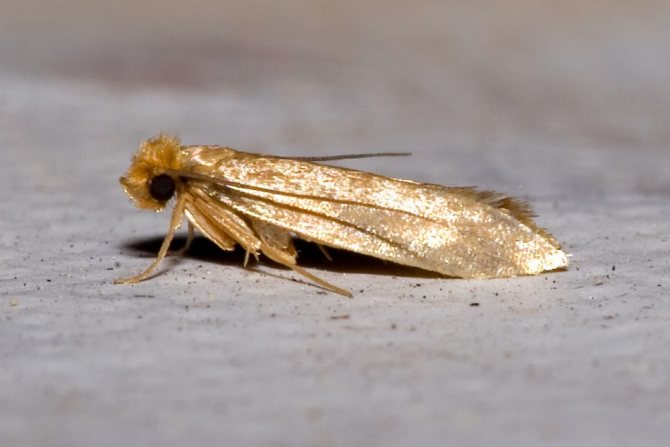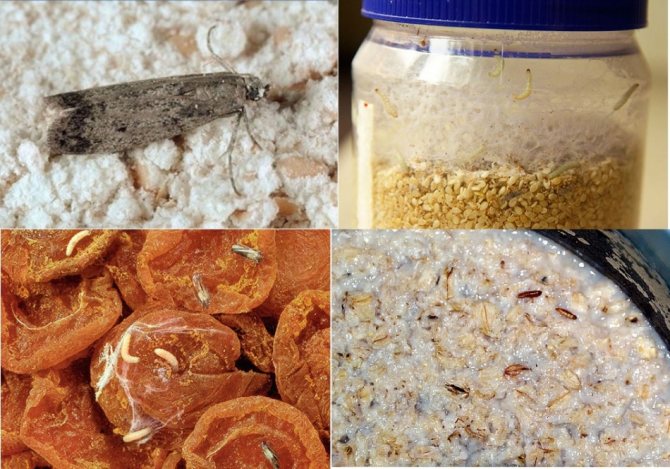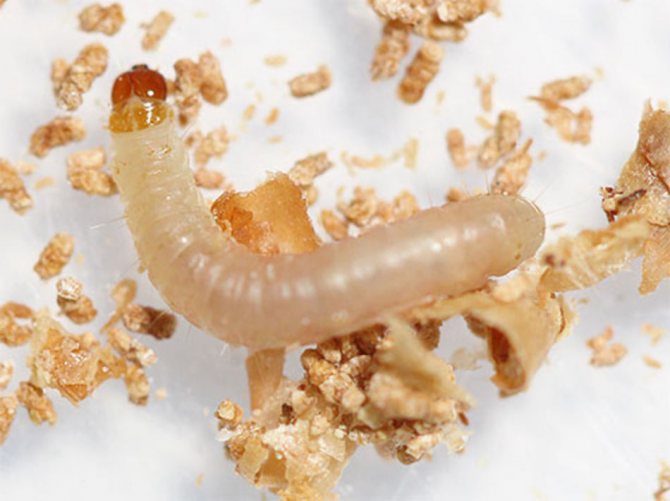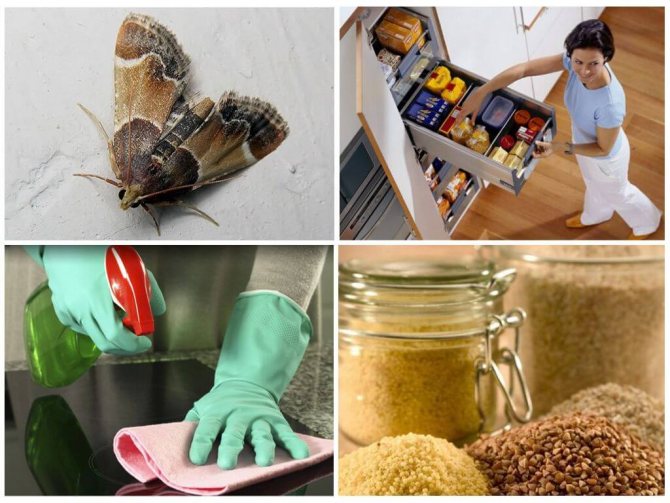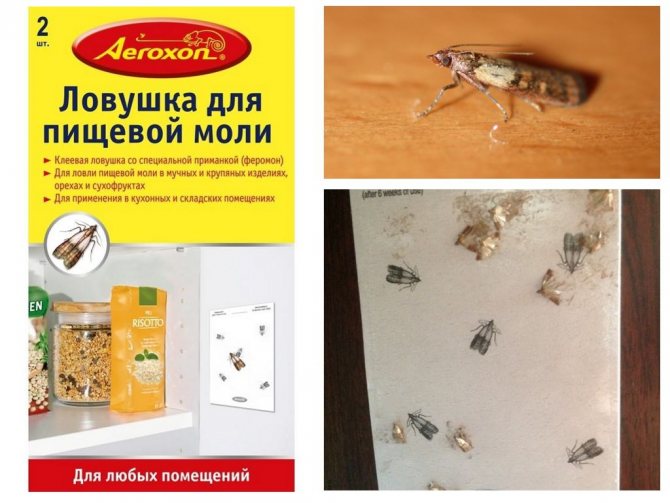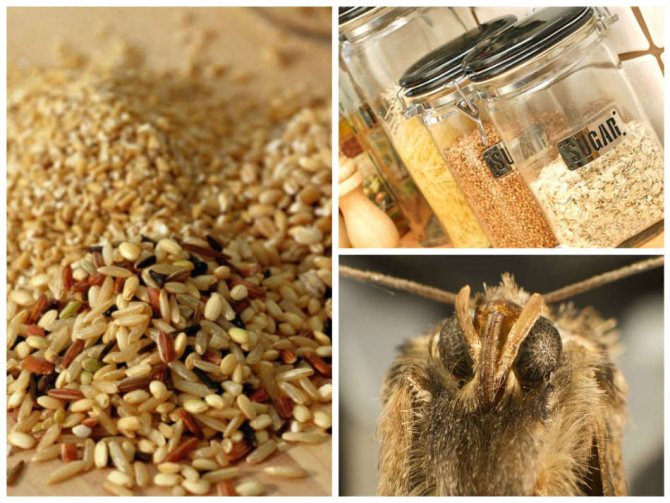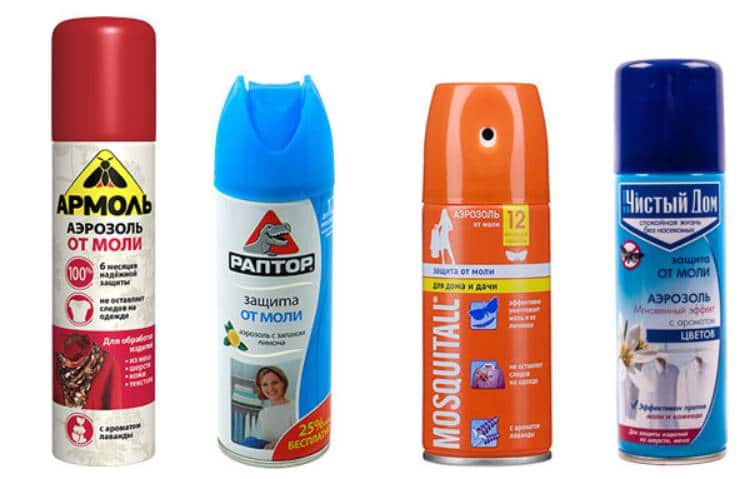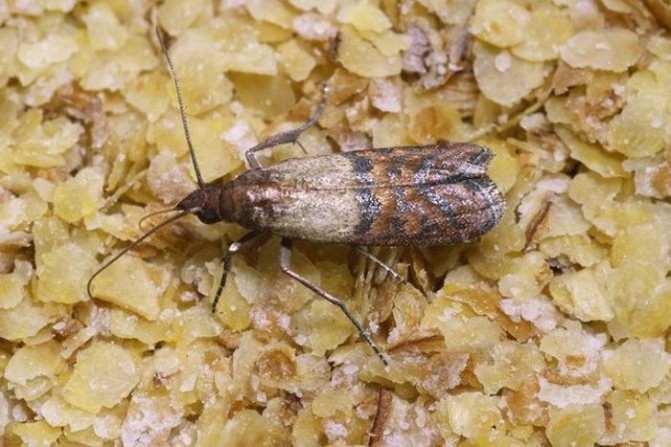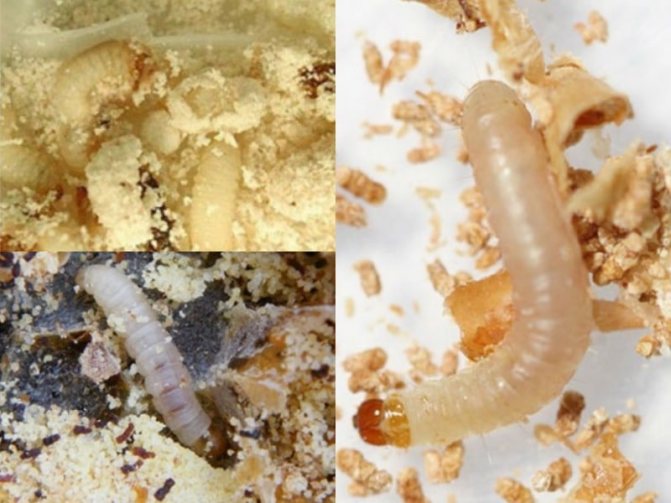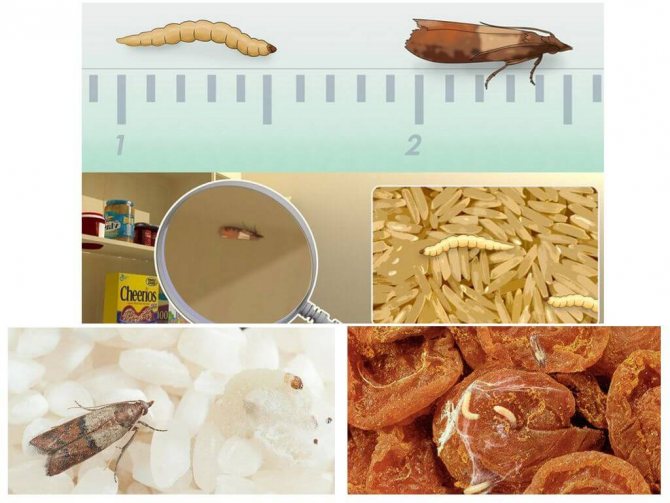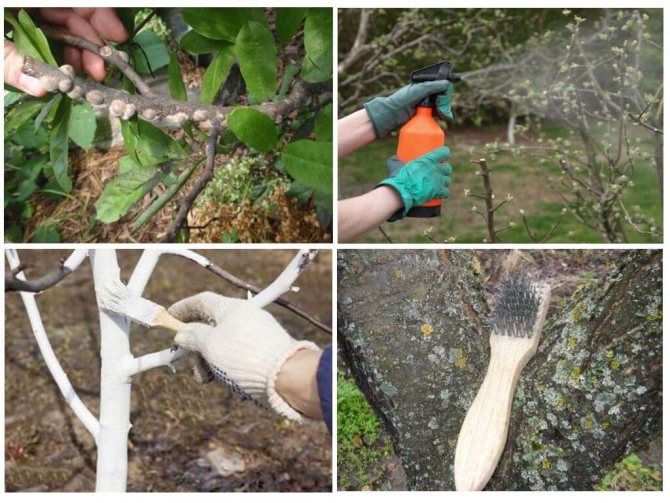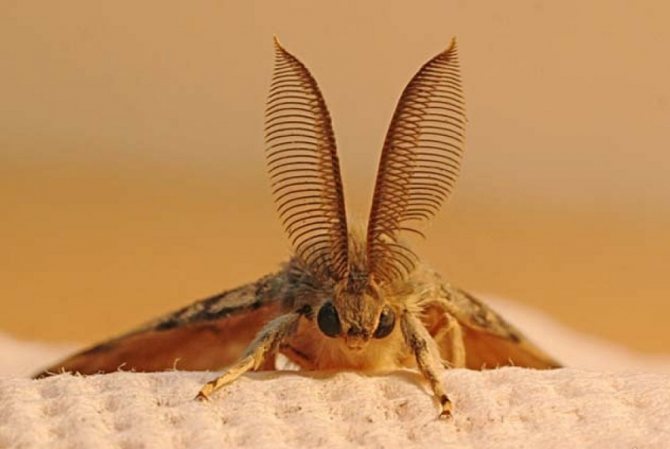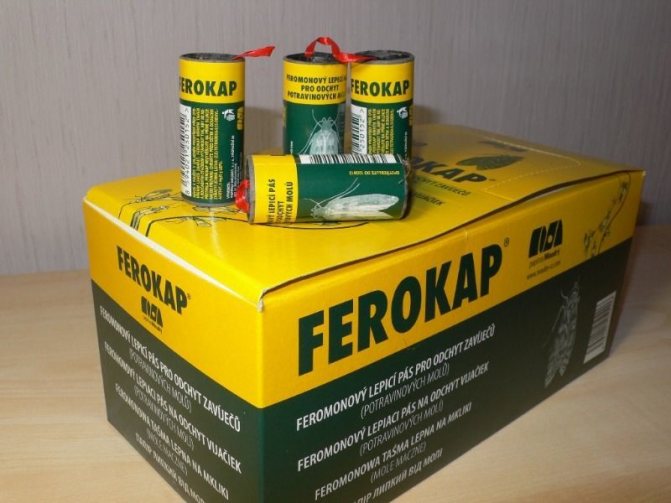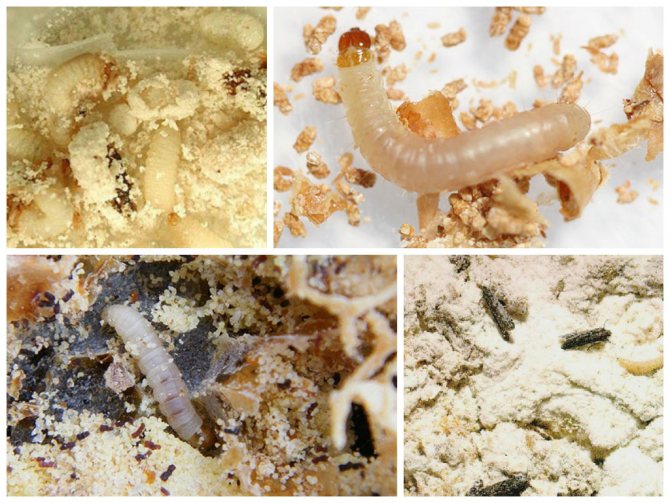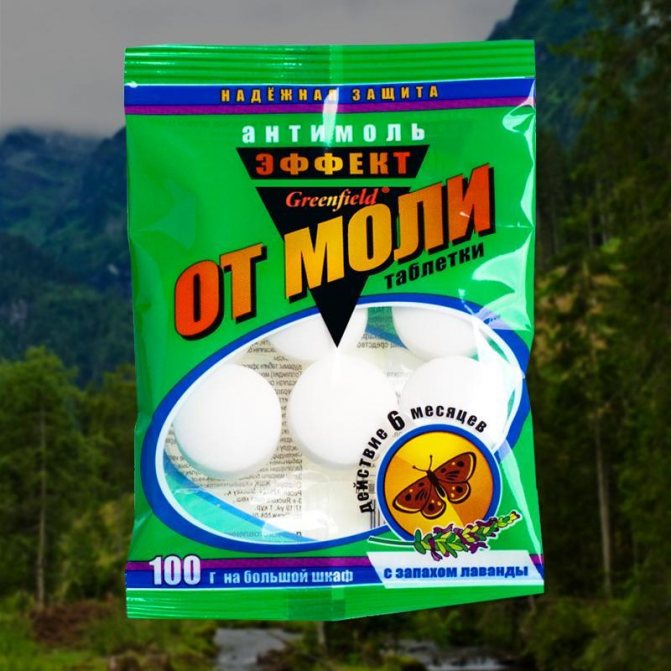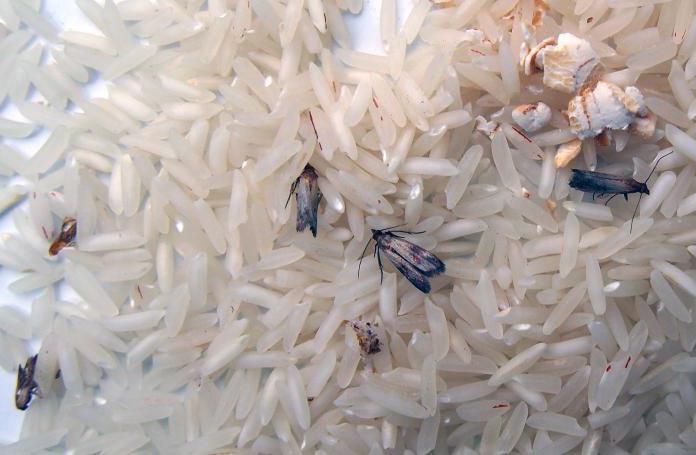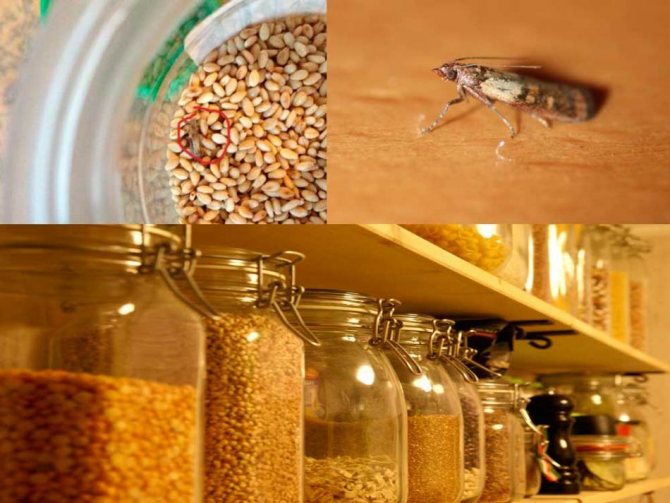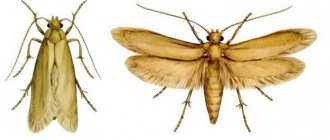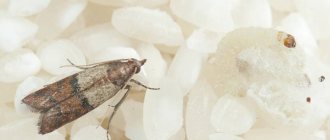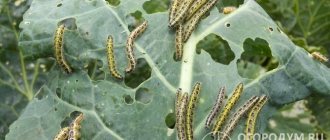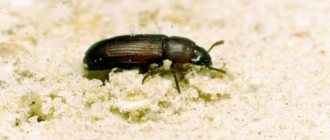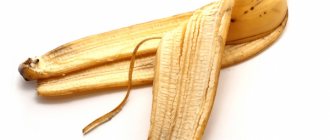The kitchen is a kind of "holy of holies" of every housewife. That is why she is jealous of any encroachment on her territory. At first glance, the appearance of a moth in the kitchen may seem just an annoying phenomenon, but in a short time this insect, which can fly, becomes a real disaster for the hostess. First of all, you need to check if moths have started up in the cereals. This is the most likely location for this insect in the kitchen.

A few words about the insect
This moth has many names, but it is more commonly referred to as a grain moth. She is a relative of the clothes moth, although not close (they belong to different families), but outwardly they are similar: the same discreet colors and the same small size up to 1 cm in length. The wings are 7 mm long, folded when planting, the insect looks like a small tubercle. Black dots are barely visible on the gray wings.
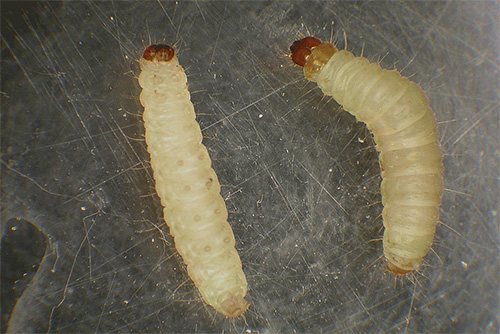

The moth larva is born in the form of a small white-yellow caterpillar, which has a dark head and a long - 1.5 cm body, divided into segments. The tenacious legs allow the insect to move along the cabinet walls. Pupa is darker in color and slightly smaller than the larva.
Food moth photo
Is there any difference between food moth and clothes moth?
The wardrobe feeds on woolen clothing or plant-derived fabrics such as silk or linen. The size of the wardrobe is slightly smaller and has a lighter color. It is easier to exterminate this type of moth, since you can treat things with a special tool, ventilate cabinets, dry-clean or wash clothes. Lavender bags or special cartridges will serve as deterrent measures.
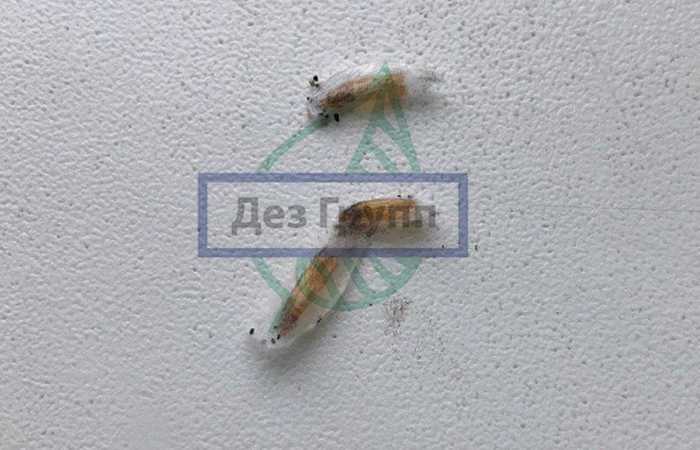

Propagation paths
It is worth saying that the reason for the appearance of this unwanted neighbor is not necessarily due to a disdain for cleanliness in the apartment. Due to some circumstances, even the most exemplary hostess in the kitchen can have different insects.
This pest has several ways to get into the kitchen area:
- From the supermarket in the most ordinary grocery bag. When buying, it is better to give preference to prepackaged and hermetically packaged cereals, flour, dried fruits and tea, because it is in these products that insects are most often found. To buy food, it is better to choose large shopping centers, in whose warehouses the conditions for storing goods are observed.
- From neighbors through ventilation grilles, therefore, it is advisable to close them with a special fine mesh.
Since the moth cannot be called an excellent flyer, it cannot spread between houses.
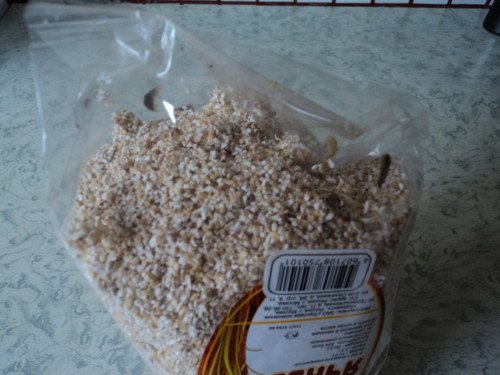

In the photo: the mole started up in a bag with cereals
Where to look for pests?
Food moth and its larvae live in places where food is concentrated: pantries, buffets, chests. Pests eat a variety of groceries: cereals, whole and crushed grains, flour, pasta, dried fruits, cookies, breadcrumbs, cereals, sugar, cocoa, tea, bread, various spices.
A clear preference is for dry foods. Insects easily penetrate any leaky packaging, from cardboard boxes to plastic bags.
You can find pests by sorting through groceries.In boxes and cans of food, bare white caterpillars, small nests with worms, silky cocoons resembling cobwebs are found.
TIP! Having found foreign inclusions in one of the products, you need to revise all the packages next to it. Most likely, pests will be found there as well.
Moth larvae and eggs enter the house with contaminated food... A weak insect cannot fly into an apartment from the street. A butterfly that has entered the house begins to multiply rapidly.
The more parasites in certain products, the more difficult it is to remove them. Each an adult butterfly can lay up to 160 eggs, new caterpillars are hatched from them within a week.
Lifestyle
The cereal moth does not live long, only a few weeks. During this time, the larva has time to be born from an egg in the form of a small caterpillar, turn into a pupa, and then into an adult. The larva leads a secretive lifestyle, is constantly in a bag with any product and crawls out of it only to pupate. After leaving the package, she begins to move along the walls of the cabinet, in search of a suitable place. The butterfly is nocturnal. She is quite active at night, she is frightened by the sunlight, so during the day she tries to hide in a dark and secluded place.
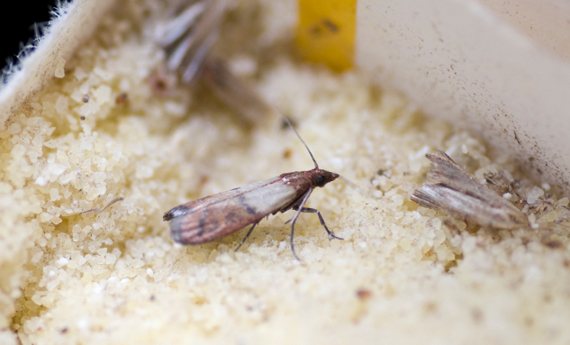

Features of the
The cereal moth is a nondescript small butterfly (up to 10 mm), gray or black. On the wings of gray insects, you can see black blotches in the form of a pattern. The pest belongs to the same family as the clothes, flour or fruit moth. A distinctive feature of cereal moth is nutrition with dry bulk products: rice or buckwheat groats, flour, grain. The insect can even live in nuts and dried fruits. Adults do not use them for food, but only lay eggs there. It is the hatched larvae that pose a threat to groceries.
The life span of the cereal moth is 5-6 days, some individuals live up to 3 weeks. The insect reproduces very quickly, having time to leave behind enough offspring. The pest hides in secluded, hard-to-reach places. The cereal moth is active at night, so it is not immediately possible to detect it.
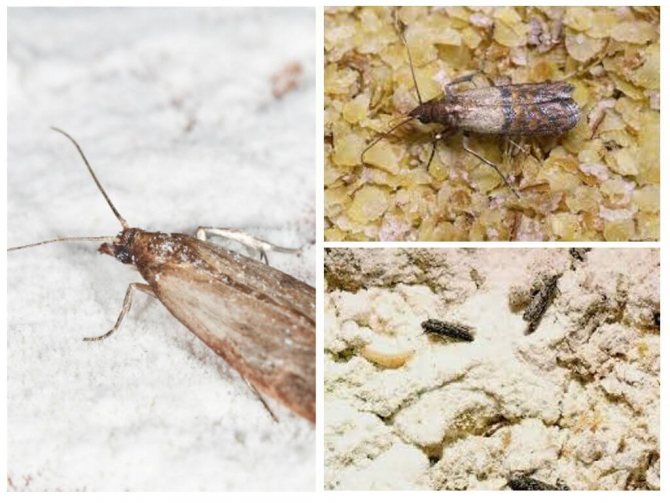

Cereal moth
How does it multiply
The reproduction of food moths occurs very quickly, so it is advisable to remove the pest as early as possible, before its population has destroyed all your supplies. The journey from a small testicle to an adult ready to reproduce takes only a few weeks. The insect develops rapidly under optimal conditions at 25 ° C heat and 50% humidity. At low temperatures indoors, the larvae develop slowly, sometimes the pupation period is delayed for months.
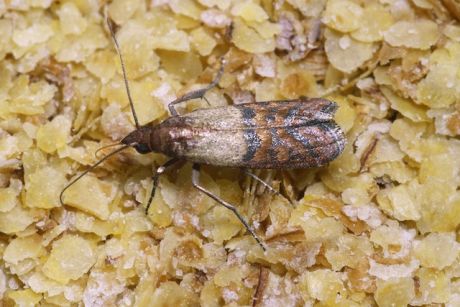

In the photo: butterfly food moth
Like all representatives of this family, the cereal moth does not eat at all due to the undeveloped mouth and lack of the digestive system. This is probably partly why she does not live long - a week or a little more. Soon after pupation, the female mates, and devotes the remaining days of her life to laying eggs, trying to lay eggs where the larvae have enough food. Moreover, she makes several clutches so that the offspring does not suffer from crowding. The male's life is even shorter, if after mating he does not find another female, then he quickly dies.
The largest wax moth has the best hearing among all insects in the world. She is able to hear sounds with a frequency of up to 300 kilohertz.
What harm does she do
Faced with the problem of food moth spoilage, every housewife should find out why this butterfly is dangerous. The main harm from it, of course, is associated with the spoilage of food. Groceries infected with moth larvae become completely unsuitable for human consumption.Products contaminated with moths in the warehouse are no longer suitable for sale. If cereals in industrial premises were damaged by a food butterfly, then this is fraught with a strong decrease in the quality of the goods and serious material costs for suppliers.
The risk of bringing moth larvae into your home increases if you buy cereals at reduced prices in the market. It is these foodstuffs that are often infected with the egg-laying of the pest butterfly.


Fur
Interestingly, the food butterfly is completely harmless to furs and garments. At the same time, such information does not at all mean that if there is a food moth in the house, there is no need to take preventive measures to prevent the appearance of a wardrobe. I must say that both of these insects feel good being close to each other. At the same time, a moth that eats food will be noticed much earlier than one that lays its larvae in dresses and woolen things.
The harm of cereal moth
Directly for humans, this moth does not pose any danger, because, unlike the same mosquitoes, it does not tolerate any diseases. But she still does harm to a person, or rather her gluttonous larvae. They not only eat food, but also contaminate it with their excrement. After that, cereals, flour and other products cannot be used for cooking. While the population of insects is small, the harm is not so noticeable to humans, however, with its increase, the losses that these insects cause begin to grow proportionally.
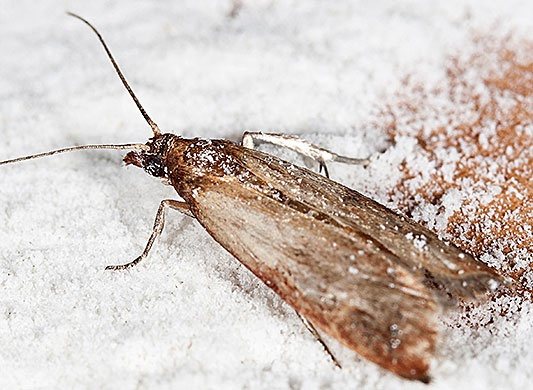

Store remedies for kitchen moths
In the store you will find several modern preparations for food moths. The most common are aerosols and traps.
Insecticidal aerosols
They guarantee a 100% result, but require extra care. This method is radical, therefore, when using it, you must definitely adhere to the instructions and dosages - they are indicated on the package. Another important condition is the availability of personal protective equipment. These include a mask, gloves, goggles, and a long-sleeved robe. Before starting processing, dishes and food are taken out of the kitchen, and the doors of cabinets and nightstands are opened. Curtains, tablecloths and other textile accessories should be washed at the highest temperature, and containers for storing cereals should be washed in a baking soda solution.
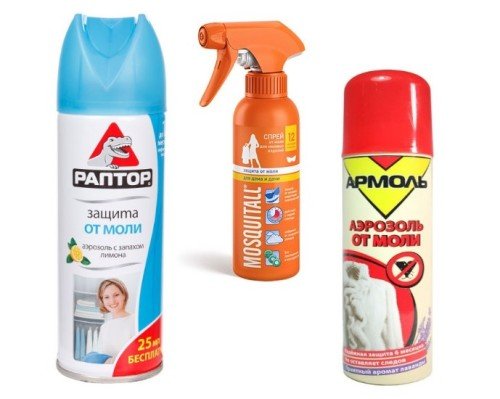

The most popular moth aerosol insecticides are:
- Antimol - suitable for spraying fabrics and kitchen furniture, reliably protects the house from any type of moth for 12 months;
- Raptor is a very effective drug that allows you to remove not only adults, but also larvae. The active effect of this aerosol is maintained for a year, provided that the furniture will not be washed. Otherwise, the treatment will have to be repeated after each wet cleaning;
- Combat is a versatile remedy for all types of moths. Absolutely safe for people and pets. "Combat" should be sprayed on the joints and walls of furniture, as well as in the corners of the kitchen.
Improper handling of chemical insecticides can result in burns to mucous membranes and hands, as well as severe food poisoning.
Traps
Another effective method for treating kitchen moths. Unfortunately, they are not able to rid the kitchen of the entire population, but they can significantly reduce the number of adults. The main advantage of such traps is ease of use.
How does a trap work? Its secret is very simple - inside there is a paper tape impregnated with glue with the addition of pheromones of adult female moths. Attracted by this smell, insects immediately adhere to the tape.
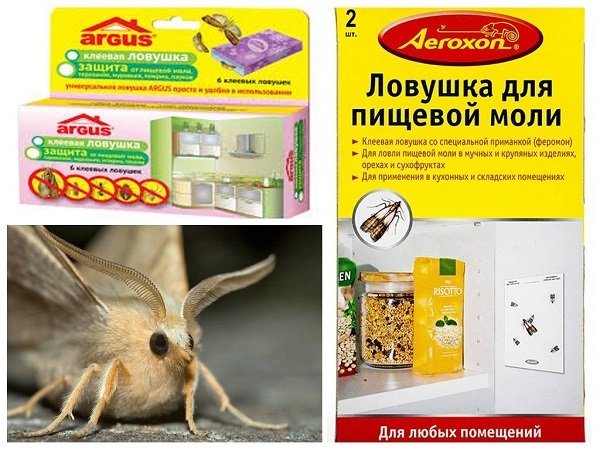

On a note! You may have noticed that moths almost never grow in dried peas, buckwheat, prunes, and polished rice.
Tips to get rid of moths in the kitchen:
Ways to fight
You need to deal with moths in cereals in stages. For which you should take the following actions:
- Take an inventory by reviewing all the food stocks in the kitchen. It is especially worth checking the jars that store cereals, flour, dried fruits. At the slightest hint of the penetration of a pest, one must not regret getting rid of all the packaging.
- Carry out cleaning. All internal surfaces of kitchen cupboards must be thoroughly washed with soapy water, wiped and allowed to dry for at least a day.
- Fry or freeze surviving food supplies.
- Pour processed foods into new and always dry jars.
Is it okay to eat contaminated foods?
Experts strongly discourage the use of contaminated cereals for cooking. When you see a butterfly in the kitchen, find its offspring and destroy it along with the reserves in which it was based. The faster you do this, the more food will survive. The larvae of the kitchen moth gnaw through the packages and eat their contents at an enviable speed, infecting everything around them with their waste, dead individuals and chitinous membranes. Once in the human body, such food can cause the development of a serious allergic reaction.
Prophylaxis
Henceforth, so that the moth has no chance to settle in the kitchen, you must adhere to the following rules:
- Don't buy a lot of products for future use.
- Periodically revise the inventory stored in kitchen cabinets.
- For storage of bulk products, use glass, plastic and metal containers with screw lids. Plastic bags are not suitable for this purpose.


Do not neglect folk remedies in the fight against this pest. They suggest that there should always be moth-repellent plants in the kitchen, which should be periodically renewed. This will prevent the appearance of cereal moths in the kitchen, which means that you do not have to get rid of it.
How to overcome a harmful moth
You can get rid of the annoying and ubiquitous living creatures, along with their offspring. Moreover, if you follow the next instruction, then you will be able to set it up in a very short period of time and there will no longer be voracious caterpillars or winged gray-brown butterflies in your kitchen.
Revision
First, you need to carefully sort out all the cereals and other grocery products. Do not be lazy, take out all the packages, cans of provisions, sort through them (manually if possible). If you notice strange movements or small black grains of sand in the rump, then immediately throw the bag along with the contents. The biggest mistake is when people try to save part of the food, believing that if you select all insects in the cereal, then this will be enough to completely eliminate moths. Do not spare the food if you see that it is infected with the larvae of harmful insects. Otherwise, you cannot avoid the reappearance of winged "intruders".
Sanitization
Having disassembled the grocery department in the kitchen, absolutely all surfaces should be processed where the moth and its larvae could start. How and how to process? Firstly, it is worth clarifying that all internal parts of cabinets, pencil cases, cupboards and all those surfaces where the slightest signs of the existence of harmful insects were found are subject to sanitation. Secondly, as for the question of how to process, then everything is simple, either you buy a special disinfectant in a specialized store, or you make it at home. But do not think that preparing a product at home means mixing the chemical elements that are usually found in any disinfectant. In order to get rid of food moth and its waste products, it is enough to treat the surfaces with a solution of laundry soap.So, after rubbing the soap on a grater, you need to leave it in water for half an hour, letting it dissolve. Ultimately, we get an excellent antiseptic and disinfectant. After carrying out such a procedure, you need to wipe the shelves dry and dry them in the open air. It is not recommended to use the shelves for their intended purpose for at least 24 hours.
Drying
If you did not find any larvae, or moths, or products of its vital activity in the cereal, then it must be given a special treatment in order to play it safe and not eat something superfluous. The most suitable option for home processing of cereals is heating in an oven to a temperature of at least 60 ° C.
Freezing
You can fight moths with another, alternative option - freezing. So, leaving the food in the freezer for several days, you can disinfect them. Even if there was nothing in the cereal, the freezing will in no way affect the quality of the food or its appearance. The main thing is to pack the dry product in a whole bag before freezing (it is best if it is paper).
Change of location
After disinfecting procedures, so that moths do not reappear in the cereal, you should pack it in another, clean and not wet container. It can be made of plastic, glass or iron - the main thing is that its covers are hermetically closed. It is recommended to put one peeled garlic clove in a container with cereals, since it is its smell, according to scientists, that repels harmful insects.
Prevention with home remedies
Some are sure that such a remedy for moths as garlic is no longer as popular as previously thought. Moreover, many housewives who got moths have repeatedly noted the fact that this insect adapts to the aroma of garlic and even begins to eat it, forgetting about cereals.
What to do if the insects that you have do not react to garlic? It makes sense to try a stronger remedy. So, some experts in this field recommend wiping the surfaces of cabinets with table vinegar, leaving the acid on the shelves for at least one hour. After that, it is advisable to wash it off using soap.
Of course, this method of fighting winged pests leaves a mark in the form of an unpleasant vinegar smell, but at the same time, the effect from it will not force itself to press for a long time, and the smell will disappear after a day.
Lavender to help
Along with "smelling" garlic and acetic acid, you can try stronger aromatic agents that help get rid of annoying winged "neighbors":
- a sprig of lavender;
- a sprig of wormwood;
- five mint leaves;
- a couple of bay leaves;
- cloves;
- chilean pepper;
- odorous geranium.
Place these items in the corners of your kitchen and replace them regularly with fresh ones.
Citrus peel
If none of the above methods of dealing with winged believers helped, and you have no idea what to do for longer, then try using lemon, orange or grapefruit peel as a flavored "amulet". You need to lay out citrus fruits on the shelves where there are traces of moths. And besides, this option of getting rid of harmful insects will fill the room of the house with a fresh aroma.
Herbal remedies
To scare off moths, you can spread some vegetable repellents in the depths of cabinets and shelves. These folk remedies have a pungent odor that pests cannot tolerate. Among the most effective plant repellents:
- pepper;
- nettle herb;
- tobacco leaves,
- geranium;
- mint leaf;
- sagebrush;
- orange peel;
- lavender.
This will prevent adults from settling in the cereal cabinet and laying eggs. But herbal remedies do not have a significant effect on the pest that is in the larval stage.
Where does the mole come from?
A mole can get into your home in three ways: through ventilation, through windows and doors, and along with purchased food. The first two are clear and less likely than the third. Moth can get into your kitchen from contaminated foods - cereals, flour, chocolate,


, nuts and even spices. The fact is that due to negligence and banal economy at the stage of special processing, moth larvae get into cereals even in granaries. Having bought even prepackaged cereals, you are not insured against this pest.
Chemical and folk remedies
From chemical means that adequately correspond to the task of how to remove cereal moth, sticky tapes are suitable. They are additionally treated with a substance that attracts insects. They can be glued along the individual walls of kitchen cabinets.
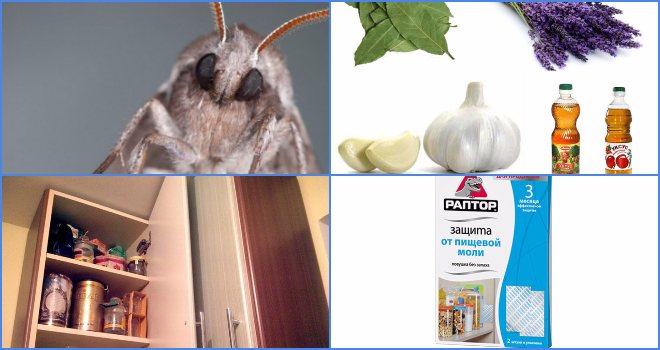

A modern remedy for cereal moth - sticky tapes
Folk remedies that help scare off cereal moths include: mint, lavender, garlic, tobacco, black pepper and citrus fruits. Therefore, in order to make the moth beg for mercy, it is enough to place these products inside the cabinets and in separate containers where the products are stored. Their smell will be inaudible for humans, but for an insect it will be very annoying.

